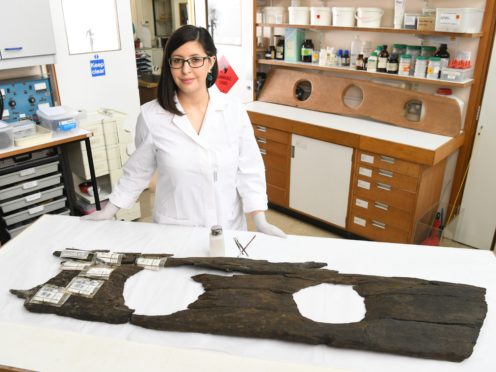A 900-year-old triple toilet seat unearthed in London is being revealed for the first time.
The ancient, communal seat, with what were once three separate holes, dates from the mid-12th century.
Built by a craftsman from a plank of oak, it is described as “invaluable” and a “rare survival”.
It was excavated from the Fleet Valley and belonged to the owners of a tenement on the banks of what was then a wide London river.
A 12th Century communal, triple toilet seat, found in London, is going on display in May at the Museum of London Docklands pic.twitter.com/xV0VPFmmKC
— Sherna Noah (@showbizsherna) February 13, 2019
The etiquette of visiting the communal toilet, and whether men and women used it at the same time, is unknown.
But experts said the identities of some of the people whose “bottoms probably sat on it” have been identified.
The communal toilet seat will go on show alongside a replica, the duplicate for selfie purposes, at the Museum Of London Docklands.
Museum of London curator of archaeology Kate Sumnall said: “The loo was found lying over a cesspit close to the River Fleet.”
“Records show a John DeFlete who made caps. In his will, he bequeathed the tenement to his wife Cassandra,” she said.
“So, what I love about this is we have the people’s names whose bottoms probably sat on it.”

It was unlikely the toilet was just used by one family but rather, “a number of people” are thought to have had access to it.
Ms Sumnall said: “We know that they owned the building … The building had four shops at the front which were probably sub-let. There was also living accommodation above ground.”
The curator added: “It’s a really fascinating object … It was absolutely usual for the time.”
It is not known how the seat was supported, whether it was with two tree trunks or part of a structure.
Other communal toilet seats have been discovered in castles around the country.
This specimen was found in 1988 in one of the biggest London excavations but went into storage.
“I think in Medieval times we were a lot less prudish than we are now and a lot less coy about bodily functions,” Ms Sumnall said.

Professor Mary Beard has previously shown off a communal toilet seat on her TV series on the Romans.
Ms Sumnall said: “Like the Romans, somewhat infamously having their sponge on a stick in lieu of toilet paper, the evidence here suggests that it was old cloth and moss that was used, so nice and cushioned!”
Viking battle axes and medieval swords, thought to have been deposited in rivers for spiritual purposes, will also be displayed, as well as skulls from a dog and a cat discovered in the River Fleet ditch.
Secret Rivers, a free exhibition, runs at the Museum Of London Docklands, from May 24 to October 27 this year.
